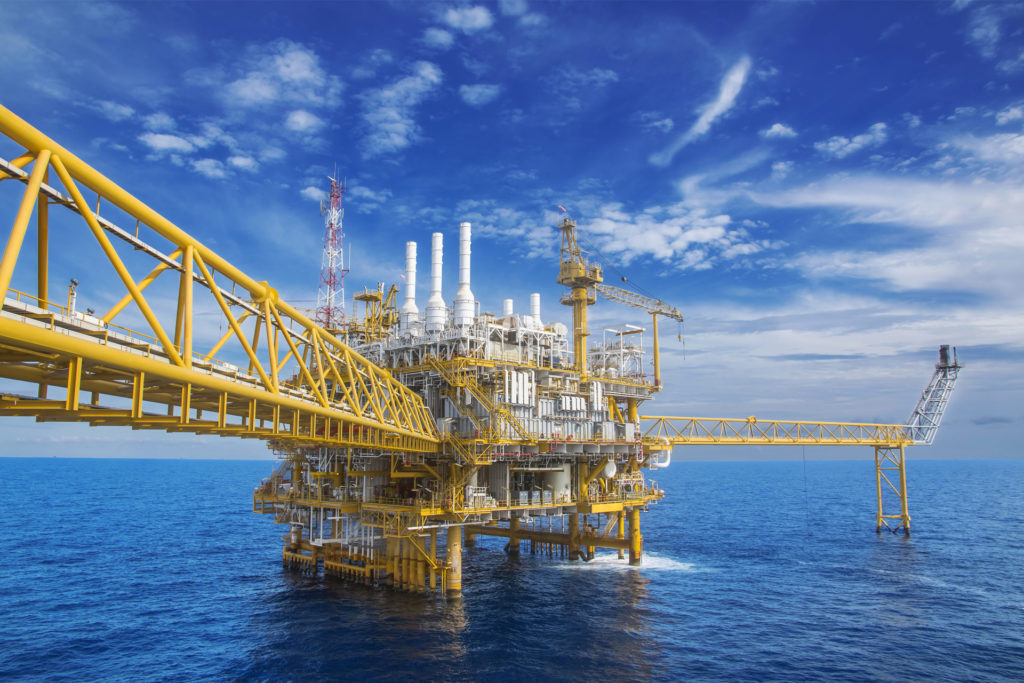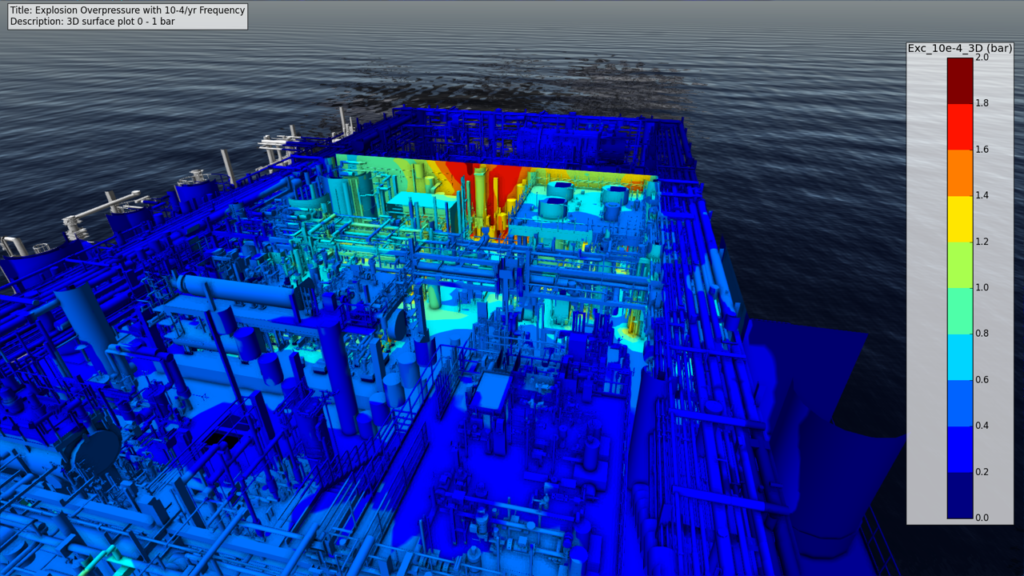
Offshore installations are threatened by various hazards which if not managed may lead to consequences such as injury or death of operators, damage to assets, environmental impact and business disruption.
The main hazards include wind and waves, fires and explosions. The topside of an offshore platform is exposed to the risk of hydrocarbon fires and explosions that unmanaged can lead to disastrous consequences.

Loss of containment events that can lead to explosions varies significantly in their magnitude and likelihood, with larger releases generally being much less frequent than the smaller ones. The consequences of any release also vary significantly. Risk-based approaches to explosion management are therefore a key part of the design of any new installation. NORSOK Z-013, for example, provides a methodology for such an approach. The application of risk-based methods is also important in supporting decision making in operations, particularly where there is a change from the original design assumptions. This can occur, for example, if a new field development is tied back to an existing facility.
However, there are a number of limitations with the explosion risk assessment methodologies. These are primarily due to the uncertainties that are inherent in the technique. Statistical data is used to provide input (e.g. wind probability data, leak frequency data, ignition probability data). Each of these statistical distributions has its own associated uncertainties. Additional uncertainties arise in the modelling techniques used to determine the consequences of a release and subsequent explosion. Finally, there is a large element of engineering judgement to select the most appropriate scenarios to consider. This brings further uncertainties to the problem.
Currently, the understanding and communication of uncertainties associated with probabilistic explosion analysis are poor. Good studies perform some level of sensitivity to try and highlight the uncertainty to the client; however, this is typically not done well or at all. Single values are often presented without any associated error bars, which get fed directly into the design.
This presents a significant point of concern because it could lead to facilities being under-designed and has been raised as a concern by regulators. For example, the UK HSE reports that:
The methodologies used for the development of exceedance across the industry curves are not consistent. The treatment of uncertainties is not clear and the wide range of methodologies employed, ranging from the use of generic curves, combinations of phenomenological and CFD modelling and solely CFD modelling prevents comparison between approaches used.
Some sources of uncertainty
Input data – e.g. Leak Rates
The Hydrocarbon Release Database (HCRD) has been compiled by the UK HSE over a 20-year period and contains details of leak and ignition events at oil and gas installations in the UK Continental Shelf. The HCRD has become a standard source of leak frequencies for offshore risk assessments, though a similar approach can be taken with any source data. For significant release events, the data is particularly sparse. As such, for this part of the parameter space, we expect the uncertainty to be high. It is important that such uncertainty is understood and included in any analysis.
Consequence Models
In reality, all consequence models will have an uncertainty associated with them. These mainly come from two sources. The first is due to a lack of knowledge about the physical processes that go into building the model. For example, there is still a lot about turbulence modelling that is not understood. The second is due to known errors in the model due to simplifications that have been applied. These may, for example, be because of spatial or temporal discretisation or because of deliberate simplification of the model to allow it to be effectively computed. CFD is generally used to perform explosion risk assessments. It is important to understand the uncertainty in these models and how it varies across the parameter space considered. Verification and validation (V&V) of CFD are the primary methods for quantifying this uncertainty. This is challenging; but despite these challenges, it is important that a judgement on the uncertainty is included in the analysis.
Sampling
To fully assess the risk a very large sample (108 scenarios) may be needed. However, for a real analysis, complicated models are used (such as CFD) that have a significant computational cost are used. As such, it is not possible to evaluate such a large number of scenarios. Most consultants will consider tens or hundreds of scenarios. With modern high-performance computing, it may be possible to push that to evaluating thousands of scenarios in a sensible engineering timescale and cost. This is still far short of the number required to ensure we have converged on the solution if a naive Monte Carlo approach is used where one samples randomly from the parameter space. Instead, scenario selection is currently based primarily on engineering judgement. A number of simplifications are then made to expand a limited number of modelled scenarios to fill the parameter space (e.g. assuming linear scaling with wind speed, the frozen cloud assumption and using equivalent stoichiometric clouds). However, it is not always clear whether these simplifications are justifiable nor is it clear how many scenarios need to be considered to ensure an accurate answer. This reduced scenario selection, hence, introduces further uncertainty into the analysis that ideally should be properly analysed and presented as part of the final output.
Including uncertainty
Through the use of robust statistical methods, it is possible to understand and include these uncertainties in our analyses. The figures below demonstrate examples of this:
Should (as is done by the majority of engineers when performing such an analysis) we neglect the uncertainty in the input distributions, we construct the single exceedance curve presented in Figure 8. We see that, at typical probabilities of interest (i.e. 10−4 /year and 10−5 /year), we predict pressures on our target of approximately 0.1 barg and 1.1 barg, respectively. However, when uncertainty is included in the analysis, the value ranges are 0 barg to 0.3 barg and 0.1 barg to 2.1 barg for 10−4 /year and 10−5 /year, respectively. Depending on what safety factor is used in any ongoing design and what, if any, uncertainty that safety factor is supposed to represent, neglecting the uncertainty may lead to significant under-conservatism in the results and significant under design.


Probability (/year) of exceeding a pressure. The first plot includes no uncertainty. The second includes uncertainty factors. The solid line shows the median value, the inner boundary the 25% and 75% quantiles and the outer boundary the 5% and 95% quantiles. The dashed red line shows the predictive posterior distribution.
How FLACS-CFD is helping engineers model uncertainty
Exciting development are underway at Gexcon to help engineers capture the uncertainty elements in their assessments.
- The validation suite for our FLACS-CFD tool is being expanded and developed to ensure we can fully understand our model uncertainty.
- We are working hard to make the tool run more quickly to allow us to reduce sampling uncertainty and, with our partners at IBM, we are working on techniques to improve scenario selection.
- Our risk assessment module of FLACS-CFD, FLACS-Risk has been developed to allow easier set up of both risk-based and non-risk-based parametric studies and we have plans over the coming period to develop it further.
The video below is an example of output from FLACS-Risk. In FLACS-Risk it is possible to show the full 3D risk picture. This allows for identification of hot spots and potentially design structures to only have extra reinforcements in areas of high forces, and not uniformly reinforced for the highest force anywhere.
The four plots on the video show the following:
- Top left: Explosion drag projected on surfaces with 10-4/yr frequency (1 per 10,000 years)
- Top right: Explosion drag as 3D volume with 10-4/yr frequency (1 per 10,000 years)
- Bottom Left: Explosion overpressure projected on surfaces with 10-4/yr frequency (1 per 10,000 years)
- Bottom Right: The geometrical model
The image below shows explosion overpressure projected on surfaces with 10-4/yr frequency

The image below shows fire radiation location-based lethality frequencies at a Hydrogen Refuelling station

For more information email flacs@gexcon.com
Do you like what you read?
Get the latest trends in the field of process safety management straight to your inbox, and enhance your skills through knowledge sharing from industry experts.
